This article needs additional citations for verification .(March 2013) |

The Golden Cross is a public house in Shrewsbury, England; it is reputed to be the oldest licensed pub in Shrewsbury.
This article needs additional citations for verification .(March 2013) |

The Golden Cross is a public house in Shrewsbury, England; it is reputed to be the oldest licensed pub in Shrewsbury.
The building is grade II* listed. The first floor is jettied with moulded bressumer and close studding. [1]

Records show that the Golden Cross was used as an inn as far back as 1428, some years before the introduction of formal licensing. Its original name was the Sextry, and it is said to have been the sacristy of Old St. Chad's Church, [1] the ruins of which can still be seen over the road in Princes Street.
The sacristy was where the church plate and vestments were kept, and it also provided lodgings for a church officer known as the sacristan. Similarly, the original name of Golden Cross Passage was Sextry Shut, [2] site of the lodgings for the Vicars Choral of St. Chad's. In 1933, a couple of timber-framed archways were discovered which a local archaeologist dated back to the time of Henry III (1216–1272), but these had apparently been covered by a later building which some unknown authority has assigned to 1428.
The Sacristy was connected to the church by a covered passageway, probably to provide shelter for the Vicars Choral as they processed to their midnight offices in the church. The passageway was subsequently demolished, and the present Princess Street now cuts across its path. Although alterations have occurred over the years, much of the building dates back to the last quarter of the fifteenth century.
The earliest surviving record for the inn is a Bailiffs' Account for 1495, which shows that the sum of 13s.2d was spent on "The King's gentlemen in sextre at the comyng home of Mr Prynce from London". It is not certain who the important "Mr Prynce" was, but there may be a connection between him and the name "Princess Street", as earlier spellings of the name give it as "Princes Street".
The first known licensee of the inn appears in 1619, when the Bailiffs' Account mentions a lawsuit between John Cleve of the Sextry and his father-in-law John Price of the Pheasant in Mardol, another part of Shrewsbury town centre.
During the Civil War a group of Royalists from the town regularly met there and were described by one of their number as " a club of good fellowship," while a member of the opposite persuasion referred to them as "a knot of company seekers."
The inn was first recorded as "The Golden Cross" in 1780 and it has been a popular meeting place throughout its history. In 1796, as part of his inaugural election as M.P. for Shrewsbury, corrupt Tory candidate William Hill bought votes from the local freemen by plying them liberally with food and drink at the Golden Cross.
In the 19th century the landlord was Thomas Harris. He was particularly proud of his dinners provided daily "for those who wished to be served at his house or at their own houses." This may have been the town's first takeaway service. He also sold fresh poultry ready for dressing and prime sausages in season.
In 1900 the inn was owned by Worthington & Co. and had six private and four public rooms. The landlady at this time was Maria Seddon, who later changed her name to Banning. She was obliged to sell the brewery's beer and stout, but she could supply her own spirits.
In February 1962 Michael and Audrey O'Dwyer became tenants of the inn. Michael was a retired National Hunt jockey and the couple were popular hosts, remaining at the inn for many years. Within a few months of their tenancy a problem arose when a section of the public wanted an end to the "Men Only" bar, which had been a longstanding tradition. When local residents heard that their sanctuary was to lose its status, 70 male customers signed a petition of protest, which was sent to the brewery by the landlord. A compromise was reached with the "Men Only" bar functioning on weekdays, but with the ladies being allowed in at weekends, a situation that continued for a number of years.
At that time, to the rear of the building, was what was traditionally known as the "Monks' Hole." In this area were two medieval stone benches and a stone table together with a spiral stone staircase which descended into a tunnel. This was one of three tunnels which emerged in three arches within the purlieu of old St. Chad's. One came from what is now Rackham's store, further down High Street and the other from the other direction.
The Golden Cross tunnel emerged in the centre arch of the three and had reputedly allowed monks [3] to cross from St. Chad's to drink in privacy, without being spotted by public. During the 1960s Mr O'Dwyer was persistently bothered by curious tourists wanting to explore the underground passage. However, once he decided to charge a shilling per visit, numbers dwindled until such time as he was able to seal the entrance to the tunnel and store his dustbins in the area. During the refurbishments of the late 1970s the entrance to the tunnel was demolished.

The Honourable Society of the Middle Temple, commonly known simply as Middle Temple, is one of the four Inns of Court exclusively entitled to call their members to the English Bar as barristers, the others being the Inner Temple, Gray's Inn and Lincoln's Inn. It is located in the wider Temple area of London, near the Royal Courts of Justice, and within the City of London. As a liberty, it functions largely as an independent local government authority.

The Abbey Church of the Holy Cross is an ancient foundation in Shrewsbury, the county town of Shropshire, England.

Bishop's Castle is a market town in the south west of Shropshire, England. According to the 2011 Census it had a population of 1,893.

Shifnal is a market town and civil parish in Shropshire, England, about 4 miles (6 km) east of Telford, 17 miles (27 km) east of Shrewsbury and 13 miles (20 km) west-northwest of Wolverhampton. It is near the M54 motorway and A5 road aka Watling Street. At the 2001 census, it had a population of 6,391, increasing to 6,776 at the 2011 census.

Burtonwood is a village in the civil parish of Burtonwood and Westbrook, in the Borough of Warrington, Cheshire, England. Within the boundaries of the historic county of Lancashire, the name Burtonwood is known worldwide as the location of the former RAF Station Burtonwood military camp. Burtonwood village itself is a few miles away from the site of the former station. The civil parish also includes Westbrook, which is a council ward and suburb of Warrington. According to the 2001 census, the population of the entire civil parish was 11,265.

Alfriston is a village and civil parish in the East Sussex district of Wealden, England. The village lies in the valley of the River Cuckmere, about four miles (6 km) north-east of Seaford and south of the main A27 trunk road and part of the large area of Polegate. The parish had a population of 829 at the 2011 census.
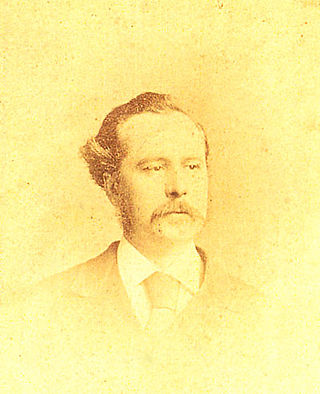
Edward Welby Pugin was an English architect, the eldest son of architect Augustus Welby Northmore Pugin and Louisa Barton and part of the Pugin & Pugin family of church architects. His father was an architect and designer of Neo-Gothic architecture, and after his death in 1852 Edward took up his successful practice. At the time of his own early death in 1875, Pugin had designed and completed more than one hundred Catholic churches.
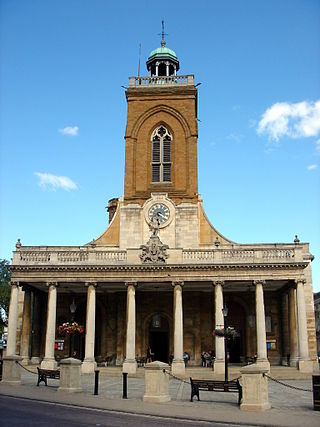
All Saints' Church, Northampton is a Church of England parish church in the centre of Northampton. The current church was largely built after a fire and was consecrated in 1680. It is a Grade I listed building.
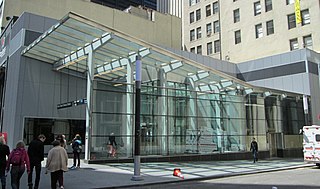
The Dey Street Passageway or Dey Street Concourse is a 350-foot-long (110 m) underground passageway in Manhattan, New York City, built as part of the Fulton Center project to rehabilitate the Fulton Street station complex and improve connectivity in Lower Manhattan. The Dey Street Passageway lies under Dey Street in Lower Manhattan, between Broadway in the eastern end, and Church Street in its western end.

Shrewsbury is a market town, civil parish, and the county town of Shropshire, England, on the River Severn, 150 miles (240 km) north-west of London. At the 2021 census, it had a population of 76,782.

The Brewery Shades is a public house on the High Street in Crawley, a town and borough in West Sussex, England. The building, which stands on a corner site at the point where the town's ancient High Street meets the commercial developments of the postwar New Town, has been altered and extended several times; but at its centre is a 15th-century timber-framed open hall-house of a type common in the Crawley area in the Middle Ages. Few now survive, and the Brewery Shades has been protected as a Grade II listed building.

Malmesbury is a town and civil parish in north Wiltshire, England, which lies approximately 14 miles (23 km) west of Swindon, 25 miles (40 km) northeast of Bristol, and 9 miles (14 km) north of Chippenham. The older part of the town is on a hilltop which is almost surrounded by the upper waters of the Bristol Avon and one of its tributaries.
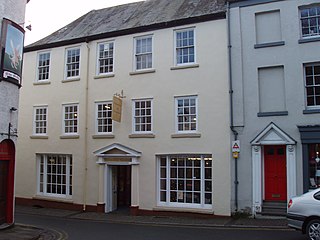
The Angel Hotel, Church Street, Monmouth, Monmouthshire, south-east Wales is a Grade II listed building. The building was in use as an inn in 1700 and closed in 1985, the longest period of continuous history of any public house in Monmouth. The building is of three storeys, with a roof of Welsh slate and a wooden Doric doorcase. During the late nineteenth century, the hotel was the headquarters of the Monmouth Branch of the Cyclists Touring Club. It is now a furniture shop, and one of 24 buildings on the Monmouth Heritage Trail.

The Falcon is a Grade II listed public house at 2 St John's Hill, Battersea, London.
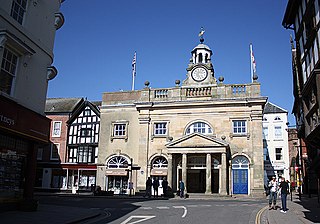
William Baker of Audlem (1705–1771) was an architect, surveyor and building contractor, working in Shropshire and the adjacent counties in the middle years of the 18th century.

The Church of St Cuthbert by the Forest is in the village of Mouldsworth, Cheshire, England. It is an active Roman Catholic church in the diocese of Shrewsbury. Its parish is combined with that of St Thomas Becket, Tarporley. The church, designed by Liverpool architect F. X. Velarde, is recorded in the National Heritage List for England as a designated Grade II listed building. The small church is distinguished by its characteristic detached campanile.

The Golden Cross is a Grade II listed public house at the junction of Customhouse Street and Hayes Bridge Road in the centre of Cardiff, Wales. The current building dates from 1903 and is noted for its distinctive ceramic tiling.
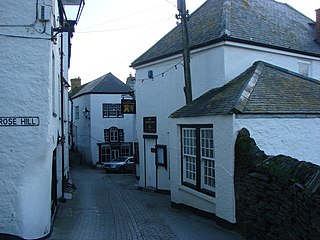
The Golden Lion is a public house on Fore Street in the English fishing village of Port Isaac, Cornwall. Believed to date from at least the early 19th century, the building may have earlier origins. It is a Grade II listed building.